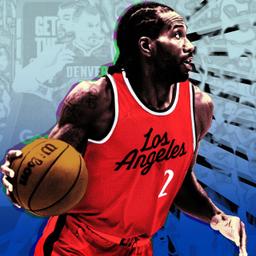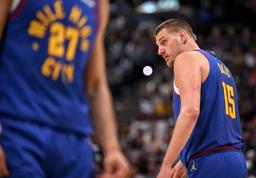It’s been almost four years since Giannis Antetokounmpo delivered one of the great inspirational quotes of this era, ensconced in his first NBA Finals experience, two games away from his eventual Finals MVP award and championship. You know the one.
When you focus on the past, that's your ego …
When I focus on the future, it's my pride …
I kind of try to focus on the moment, in the present—that's humility.
But rumormongers are not particularly humble folk, and after the Milwaukee Bucks’ toothless Game 1 performance against the Indiana Pacers last Saturday, they once again smell blood in the water. The prospects of yet another early-round exit—which would be the Bucks’ fourth straight since winning the title in 2021—feed into what feels like a yearly compulsion to fixate on Giannis’s future. In a way, it’s all we’ve been primed to do with him. Few players in NBA history have so fully and seamlessly embodied the transformation from prototype to archetype, rewarding prognosticators tantalized by the potential of what he could be. Giannis arrived in the league as a spindly 6-foot-9 teenager and has undergone one of the most dramatic metamorphoses in sports, emerging as a 6-foot-11 titan. Once a vessel of limitless, unknowable possibility, Giannis has grown into one of the most consistent forces in basketball history. He’s a player who has consistently dared fans to dream bigger, and over the past half decade, the central tension of Giannis’s charmed career has fallen not on his own ability, but on the scope of the imagination around him.
It was hard to watch the Bucks play seemingly three steps slow on both sides of the ball in Game 1 and not see the ruins of a bygone ecosystem. Antetokounmpo was, as always, flirting with transcendence. But even he struggled to process the floor at times, a lag time that came from a lack of trust in his teammates, inviting the Pacers’ swarming help defense to arrive in the blink of an eye and deflect, dislodge, and disorient. It didn’t help that he was playing alongside ghosts. The glacial speed of Brook Lopez defending in space, entombed by the very principles of “drop” pick-and-roll coverage that he helped popularize, is untenable against an Indiana squad energized by persistent ball movement. Ryan Rollins was a bright spot not only in the game but also across the season as a whole, but he does not begin to approximate the game-altering influence of Damian Lillard, who will return for Game 2 after a stunningly quick recovery from deep vein thrombosis. Deadline acquisition Kyle Kuzma had one of the least effective playoff performances ever, with zeroes across the board in 22 minutes of action (a feat that has been met only by Brent Barry for the Spurs 20 years ago). Knowing that Kuzma was supposed to be an upgrade over franchise hero Khris Middleton made it all the worse. A starting wing duo of Kuzma and Taurean Prince is not how you optimize your title chances with Giannis; it’s how you optimize an apocalypse.
For years now, Giannis has seemingly gotten the most out of himself in spite of coaching rather than because of it. Between former coach Mike Budenholzer’s reluctance to push Antetokounmpo beyond Giannis’s own perceived thresholds and Doc Rivers’s retrograde lineup decisions, Giannis may have had only one or two seasons playing in an environment optimized for his gifts. (True to Giannis form, in one of those years, they won the whole damn thing.) It’s a testament to Antetokounmpo’s generational talent that the flawed Bucks have consistently remained contenders, although injuries in the past few seasons have robbed him of the chance to show just how dominant of a player he’s become since his first ring. His lack of postseason exposure has caused a sort of object impermanence. A few days ago, ESPN somehow ranked Antetokounmpo as the sixth-most impactful player of the postseason, which toggles between a masterful pretzeling of reality and a willful neutering of meaning.
Yet every possible statistical query one might run on Antetokounmpo has him communing with legends. He has been in the top four in MVP voting for seven consecutive seasons, a feat previously accomplished by just six players who’d be on anyone’s all-time top-10 list. He has more seasons with per-game averages of 30 points, 10 rebounds, and five assists than either Wilt Chamberlain or Oscar Robertson—all in Antetokounmpo’s three most recent seasons. He’s also shot better than 60 percent from the field in back-to-back seasons, which is something that the basketball world has just decided to take for granted, I guess. Wilt never did that in his prime; Shaq got there, but only once he was a clear second option behind Dwyane Wade in Miami; Kareem had only one season at 60 percent shooting.
Over the past few years, I’ve been considering what a modern portrait of dominance looks like in the league today. When drawing parallels, my mind invariably goes back to Shaq, the monolith of my youth. Joel Embiid comes the closest in physical proportions and in mythic quality, but in terms of raw output, Giannis has proved to be O’Neal’s true spiritual heir.
Shaq and Giannis are damn near statistical doppelgängers when you compare their output from age 25 to 30, spanning six seasons. Shaq averaged 28.1 points and 11.8 rebounds, shooting 57.6 percent from the field on 19.1 field goal attempts per game in that span; Giannis averaged 29.9 points and 11.9 rebounds, shooting 57.5 percent on 19.2 field goal attempts per game. Of course, Antetokounmpo’s overall field goal percentage is skewed by long-distance attempts that Shaq never took. (Giannis’s average shot distance across his career is more than twice Shaq’s.) Giannis’s 2-point field goal percentage over the past six seasons (62.4 percent) tops that of any single season Shaq ever produced in his prime.
It’s time to place Antetokounmpo as the most physically dominant player of his era, and right up there with Wilt and Shaq as the most physically dominant players in league history. But “there is something backhanded in the nature of the most dominant debate as it pertains to the NBA—it’s a consolation of sorts,” I wrote last year about Embiid. “‘Dominance’ is often cast as something separate from ‘best.’” The only player with a better 2-point field goal percentage than Antetokounmpo over the past six seasons, on at least 10 attempts per game? Nikola Jokic.
“I really believe if the last three to four years, maybe five years of my career that were from 2020 until 2025, and they were, like, from 2010 to 2015, I think I would have won five straight MVPs,” Antetokounmpo said before the series. “But the thing is that talent right now is at an all-time high. What’s going on in the league right now, it’s incredible.”
In those two sentences, we see both Giannis’s ego and humility, by his own definition. Even for a player as great as Antetokounmpo, there is no denying how large Jokic’s presence looms. In that shadow, Giannis has somehow become underrated on a historical scale, even though he’s arguably been the second-best player in the league for a number of years now. He is no longer the biggest physical anomaly in the league. He is no longer the smoothie-addled prince who was promised. But he is, true to the Yoruba roots of his surname, royalty that has arrived from overseas. The general public’s inability to hold multiple truths at once points to a lack of grace. A skill issue on our part, not Giannis’s. It’s been frighteningly easy to take his remarkable run for granted. Once upon a time, these were the days we’d prayed for.
The late, great Jonathan Tjarks used to muse about the possibility of Giannis. I always found it fascinating that his thoughts were typically presented as lamentations. Back then, Antetokounmpo was still experimenting with who he felt he ought to be as a player, still toying with the notions of positionality and what it meant to be a lead creator at his size—still hearing the faint whispers of years past suggesting he become a true point guard. Tjarks would wonder what Giannis might look like if he stopped trying to fight the current of the player he was so obviously becoming.
“Giannis should be building his game from the inside-out, not the outside-in,” Tjarks wrote at the beginning of 2021, less than half a year before Giannis and the Bucks reached the pinnacle. “Shots at the rim and the 3-point line are the most efficient, but you can’t skip steps along the way when working on your jumper. The 3-pointer is the dessert. They should be the reward for a big man who has put in the work closer to the basket. Midrange shots are like eating your vegetables. They’re not as glamorous or as fun, but they are more important. For Giannis, having those moves in his bag would force defenses to change how they guard him.”
Four years later, Tjarks’s vision has been realized. Antetokounmpo turned himself into one of the best midrange scorers in the league overnight. Giannis shot 46.2 percent on long 2s at least 17 feet out this season, according to Synergy Sports. Only long-2 legend DeMar DeRozan had more attempts from that range, and of the top 10 in attempts—a list that includes superstars like Devin Booker, Anthony Edwards, Donovan Mitchell, LeBron James, and Shai Gilgeous-Alexander—only Booker shot a higher percentage from that range this season.
It’s a welcome addition to his game that has added new dimensions to his playmaking—the extra beat of consideration from defenses guarding him at the elbows creates new driving lanes and kick-out possibilities. It unlocks a vision of Giannis that, for years, had yet to be fully tapped: Antetokounmpo at the 5, with shooters and switchable defenders all around him, giving him the space to make plays on both ends of the floor. Milwaukee’s best lineup in Game 1, and its best lineup for much of the regular season’s final stretch, has hewed to that template. A best-of-seven series presents the opportunity to wipe a slate clean. Starters are not starters by birthright; reserves are not inherently less valuable. The Bucks, as lowly as their roster appears, have combinations that have proved effective. But Rivers has been historically slow to make sweeping adjustments, clutching tightly to his fatalistic résumé and reputation that have become a rather famous self-fulfilling prophecy. It isn’t safe to assume that any dramatic changes will be made. Which is kind of the impasse we’re at with Giannis, isn’t it?
Antetokounmpo and the Bucks face an uphill battle against not only the Pacers but also time itself. It says a lot about a team when its postseason hopes hinge on a player making a miraculously quick recovery from a blood clot and immediately returning to All-Star form. Giannis alone can keep Milwaukee in the series—his 36 points in Game 1 came with ease, and his eight potential assists on Saturday yielded only one actual assist, which ought to stabilize f Lillard makes his return and the rest of the team returns to the land of the living. The series is far from over, but the buzzards will be circling above, just in case.
Bucks fans ought to be annoyed by the trade chatter happening just one game into a playoff series, but it’s shocking how quickly premature sentiments can calcify into inevitabilities. Antetokounmpo can single-handedly bring his team back from the brink should they find themselves there, but for how much longer?
The Luka Doncic trade’s ripple effects will echo through the NBA’s eternity, but it was notable that, in the immediate afterglow, the pure shock provoked Giannis to verbalize what had clearly weighed on his mind over the years. A hypothetical no fan wants to hear: “When a player believes that he can go to a different team and he believes he can have a chance to win a championship, we cannot crucify the person and say that he’s not loyal and he didn’t do the right thing and he let everybody down,” Antetokounmpo told reporters in early February. “Because history has shown you, you have to do what is best for you and your family. You have to do what’s best, most important to win.”
Giannis hasn’t stopped improving on his own impossible standard, whether or not his team has followed suit, whether or not the viewing public has bothered to notice. Bucks fans are used to this by now, but there’s no real way to brace for the moment when the present and future finally collide. There’s no way to know just how much longer a monumental talent like Giannis will be around.
When you focus on the past, that's your ego … When you fixate on the uncertainty of what’s to come? That’s anxiety.





